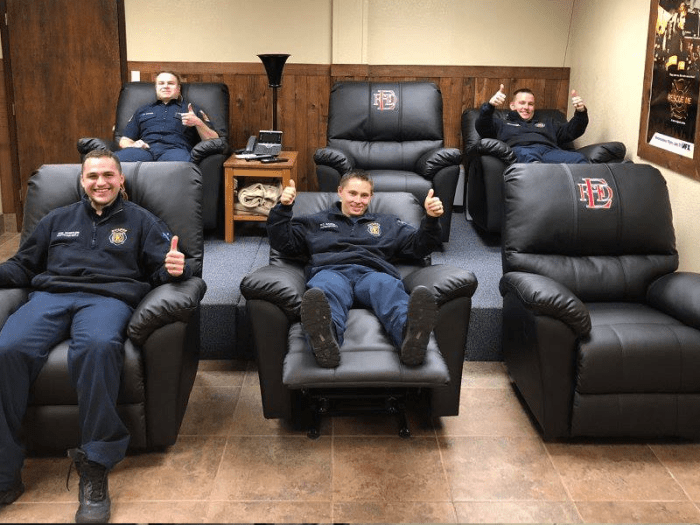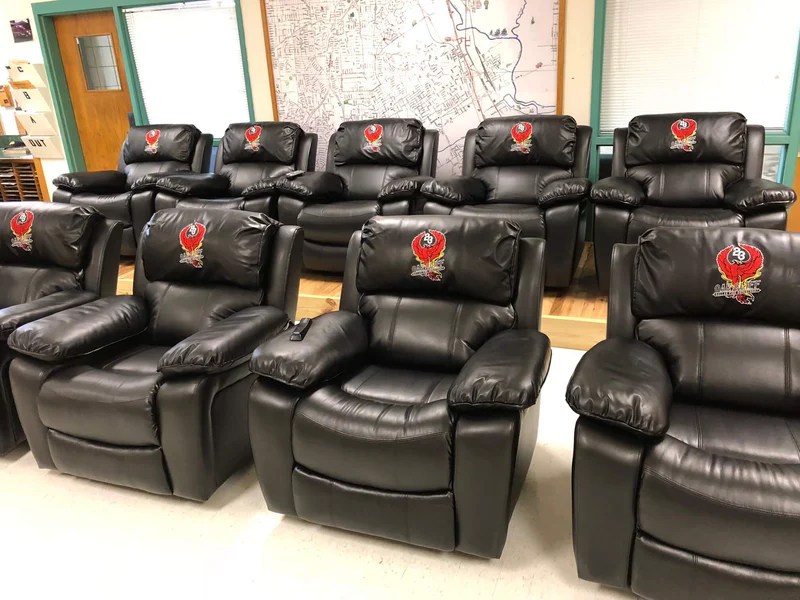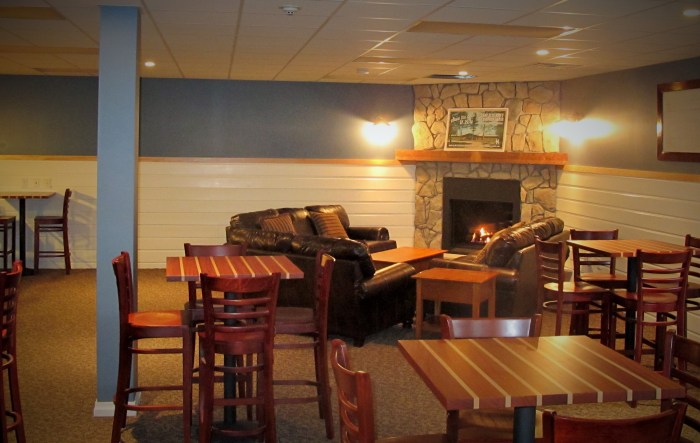Fire station furniture plays a crucial role in supporting the demanding operations of firefighters. From ensuring functionality and ergonomics to optimizing space and creating a welcoming ambiance, every aspect of furniture design contributes to the efficiency, comfort, and well-being of these brave individuals.
This comprehensive guide delves into the essential considerations for fire station furniture, exploring the latest trends and innovations that are transforming the industry. We’ll discuss the importance of durability, space optimization, aesthetics, and customization, providing valuable insights for fire departments seeking to create optimal work environments for their firefighters.
Functionality and Ergonomics

Fire station furniture is not merely about aesthetics but also about functionality and ergonomics. Every piece of furniture should be designed to support firefighters’ daily operations, ensuring comfort and efficiency during extended work shifts.
Ergonomic considerations are crucial in fire station furniture design. Firefighters often work in demanding and physically taxing environments, so their furniture should provide support and minimize discomfort. This includes chairs with adjustable lumbar support, desks with ergonomic keyboards and mouse placement, and comfortable sleeping arrangements for rest periods.
Furniture Design for Firefighters’ Needs, Fire station furniture
- Firefighter turnout gear storage:Dedicated storage units for turnout gear, including compartments for helmets, boots, gloves, and other equipment, keep gear organized and accessible.
- Kitchen and dining areas:Functional kitchens and dining areas allow firefighters to prepare and enjoy meals, fostering camaraderie and providing nourishment during long shifts.
- Training and exercise equipment:Fire stations often include fitness facilities with specialized equipment tailored to firefighters’ physical demands, such as cardio machines, weightlifting equipment, and obstacle courses.
- Sleeping quarters:Comfortable sleeping quarters provide firefighters with a place to rest and recharge, ensuring they are well-rested for their demanding work.
- Common areas:Common areas, such as lounges and recreation rooms, offer firefighters a space to socialize, relax, and decompress.
Durability and Materials
Fire station furniture faces rigorous demands due to the high-intensity work environment. To ensure longevity and resilience, durability is paramount.Specific materials and construction methods are employed to withstand wear and tear. Durable fabrics like leather or vinyl are often used for upholstery, while sturdy metals or hardwoods provide structural support.
Fire-resistant materials are essential to prevent ignition and minimize the spread of flames.Maintenance and cleaning procedures play a crucial role in preserving the furniture’s lifespan. Regular cleaning removes dirt and grime, while periodic inspections identify any potential damage or wear.
Prompt repairs or replacements extend the furniture’s functionality and aesthetic appeal.
Material Considerations
Leather
Durable, fire-resistant, and easy to clean.
Vinyl
Cost-effective, water-resistant, and available in various colors and textures.
Metals
The functionality and durability of fire station furniture are essential, but comfort and style shouldn’t be overlooked. Delivery of such specialized furniture often raises the question: “Do I tip furniture delivery?” Click here to learn about tipping guidelines for furniture delivery.
By ensuring the delivery team is well-compensated, you not only show appreciation but also encourage careful handling of your valuable fire station furniture.
Strong, fire-resistant, and easy to maintain.
Hardwoods
Durable, aesthetically pleasing, and resistant to scratches and dents.
Fire-resistant materials
Comply with safety regulations and minimize the risk of ignition and flame spread.
Maintenance and Cleaning
- Regular cleaning removes dirt, dust, and spills.
- Periodic inspections identify potential damage or wear.
- Prompt repairs or replacements maintain functionality and aesthetics.
- Use cleaning products specifically designed for the furniture’s materials.
- Avoid harsh chemicals or abrasive cleaning methods.
Space Optimization and Layout
Fire stations often face space constraints due to the need to accommodate various equipment, vehicles, and personnel. Furniture design plays a crucial role in optimizing space utilization and ensuring efficient operations.Furniture configurations should maximize functionality while maintaining accessibility and flow.
For instance, modular furniture allows for flexible arrangements that can adapt to changing needs. Multi-purpose furniture, such as tables with built-in storage or benches with integrated seating, saves space and enhances functionality.
Space-Saving Solutions
Innovative space-saving solutions further enhance space utilization. Wall-mounted cabinets and shelves maximize vertical space, while foldable or retractable furniture can be easily stored when not in use. Automated storage systems, such as carousels or vertical lifts, provide high-density storage and quick access to equipment.
By incorporating these space-saving measures, fire stations can create efficient and functional work environments within limited areas.
Fire station furniture often requires special considerations due to its durability and functionality. If you need to move fire station furniture across the country, it’s crucial to choose a reliable shipping company that specializes in shipping furniture across country . They will ensure your furniture arrives safely and securely at its destination.
When selecting furniture for your fire station, consider factors such as comfort, durability, and ease of maintenance.
Aesthetics and Ambiance

In fire stations, furniture plays a crucial role in shaping the overall ambiance and fostering a sense of camaraderie and professionalism. The choice of design elements, colors, and materials can significantly impact the mood and motivation of firefighters, creating a welcoming and cohesive space that reflects the identity and values of the department.
Design Elements and Colors
Fire stations often incorporate design elements that evoke a sense of strength, resilience, and community. Angular lines and bold colors, such as red and yellow, are commonly used to convey a sense of urgency and action. Natural elements, such as wood and stone, add warmth and a touch of nature to the space, creating a more inviting and comfortable environment.
Materials and Textures
The choice of materials and textures in fire station furniture is equally important. Durable and easy-to-clean materials, such as leather and vinyl, are ideal for areas that experience high traffic and potential spills. Soft and comfortable fabrics, such as cotton and wool, can be used in lounge areas or offices to create a more relaxed and inviting atmosphere.
Reflecting Identity and Values
Furniture in fire stations can also be used to reflect the identity and values of the department. Custom-designed pieces, featuring the department’s logo or crest, can create a sense of pride and belonging among firefighters. Furniture that incorporates elements of local history or culture can further enhance the station’s connection to the community it serves.
Customization and Personalization: Fire Station Furniture

Fire stations are unique environments with specific needs that require furniture tailored to their requirements. Customizable furniture allows fire stations to design spaces that meet their specific functional and aesthetic requirements.
Personalized furniture enhances firefighter comfort, morale, and sense of ownership. When firefighters have input into the design of their furniture, they are more likely to feel connected to their workspace and take pride in their station.
Examples of Customizable Furniture
- Modular seating:Fire stations can create flexible seating arrangements that adapt to different needs, such as training sessions, meetings, or relaxation.
- Height-adjustable desks:Firefighters can adjust their desks to their preferred height, reducing strain and discomfort during extended work sessions.
- Custom storage solutions:Fire stations can design storage solutions that accommodate their specific equipment and gear, ensuring efficient organization and easy access.
Emerging Trends and Innovations
Fire station furniture design is constantly evolving to meet the changing needs of firefighters. In recent years, there has been a growing emphasis on functionality, durability, and aesthetics. New materials, technologies, and design concepts are transforming the industry, and these innovations are having a major impact on the future of fire station furniture.
Innovative Materials
One of the most significant trends in fire station furniture design is the use of new materials. These materials are often lighter, stronger, and more durable than traditional materials, and they can also be more resistant to fire, heat, and chemicals.
Some of the most popular new materials include:
-
-*Polymer composites
These materials are made from a combination of plastic and fiberglass, and they offer a high strength-to-weight ratio. They are also resistant to fire, heat, and chemicals, making them ideal for use in fire stations.
-*Stainless steel
Stainless steel is a corrosion-resistant alloy that is often used in fire stations because of its durability and ease of cleaning.
-*Recycled materials
Fire station furniture manufacturers are increasingly using recycled materials to reduce their environmental impact. These materials can include recycled plastic, metal, and wood.
Innovative Technologies
New technologies are also being used to improve the functionality and durability of fire station furniture. These technologies include:
-
-*Computer-aided design (CAD)
CAD software is used to create 3D models of fire station furniture, which can then be used to optimize the design for functionality and durability.
-*Finite element analysis (FEA)
FEA software is used to analyze the stress and strain on fire station furniture, which can help to identify potential weak points and improve the design.
-*Rapid prototyping
Rapid prototyping technologies, such as 3D printing, can be used to create prototypes of fire station furniture quickly and inexpensively. This can help to speed up the design process and ensure that the furniture meets the needs of firefighters.
Innovative Design Concepts
New design concepts are also being used to improve the aesthetics and functionality of fire station furniture. These concepts include:
-
-*Modular furniture
Fire station furniture is designed to withstand the rigors of a demanding environment. Whether you’re looking for sturdy chairs for the break room or durable desks for the dispatch center, you’ll need furniture that can handle the wear and tear.
If you’re moving your fire station across the country, cross country furniture shipping companies can help ensure your furniture arrives safely and on time. They specialize in handling large, bulky items and can provide a variety of services to meet your specific needs.
Once your furniture arrives at your new fire station, you can rest assured that it will be ready to serve you for years to come.
Modular furniture is designed to be reconfigurable, so that it can be easily adapted to changing needs. This type of furniture is ideal for fire stations, where the layout of the furniture often needs to be changed to accommodate different activities.
-*Ergonomic furniture
Ergonomic furniture is designed to provide comfort and support for firefighters. This type of furniture can help to reduce fatigue and injuries, and it can also improve productivity.
-*Multifunctional furniture
Multifunctional furniture is designed to serve multiple purposes. This type of furniture can help to save space and improve efficiency in fire stations.
The emerging trends and innovations in fire station furniture design are having a major impact on the industry. These innovations are making fire station furniture more functional, durable, and aesthetically pleasing. They are also helping to improve the safety and well-being of firefighters.
Concluding Remarks
In conclusion, fire station furniture is a critical investment that can significantly enhance the functionality, durability, and ambiance of these vital facilities. By carefully considering the unique needs of firefighters and incorporating innovative design solutions, fire departments can create spaces that support their operations, boost morale, and foster a sense of pride and ownership.
As the industry continues to evolve, we can expect to see even more advancements in fire station furniture, driven by a commitment to providing firefighters with the best possible tools and environments to serve their communities.
Query Resolution
What are the key considerations for choosing fire station furniture?
Functionality, durability, space optimization, aesthetics, and customization are the primary factors to consider when selecting fire station furniture.
How can furniture design improve the functionality of fire stations?
Furniture specifically designed for firefighters’ needs, such as ergonomic chairs, height-adjustable desks, and storage solutions that maximize accessibility, can significantly enhance operational efficiency.
What materials are commonly used in fire station furniture?
Durable materials such as metal, solid wood, and fire-resistant fabrics are commonly used to withstand the demanding conditions of fire stations.